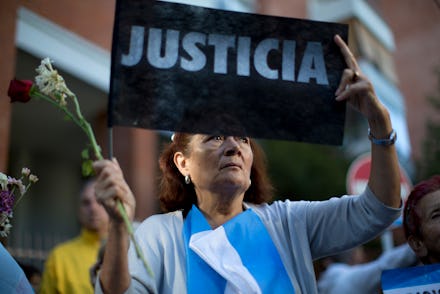Everything You Need to Know About the Insane Assassination Drama Unfolding in Argentina

The lead investigator into the death of Alberto Nisman (the special prosecutor who had accused Argentine President Cristina Fernández de Kirchner of orchestrating a cover-up) announced on Tuesday a stunning finding: Nisman had recently drafted an arrest warrant for Kirchner.
Nisman was found dead in January, apparently from a self-inflicted gunshot to the head, just hours before he was set to testify in front of Congress — but Nisman didn't own a gun.
The New York Times reports that the 26-page warrant, found stuffed in Nisman's garbage, also called for the arrest of foreign minister Héctor Timerman. Both Kirchner and Timerman had repeatedly denied that they were seeking a secret deal with Iran to lift arrest warrants for Iranian officials connected with the 1994 bombing of a Jewish center in Buenos Aires — the same case that Nisman had been working on for a decade.
Here's what you need to know about this insane drama unfolding in Argentina:
The background: On March 17, 1992, the Israeli embassy in Argentina's capital, Buenos Aires, was attacked by a car bomb that killed 29 people and injured more than 250 others. Two years later, a van loaded with more than 600 pounds of ammonium nitrate fertilizer and gasoline exploded outside the Asociación Mutual Israelita Argentina Jewish community center in the same city, killing 85 and injuring more than 300.
In 2004, former President Nestor Kirchner appointed Nisman to investigate the massacre at AMIA after a decade of botched investigation. Two years later, Nisman and co-prosecutor Marcelo Martínez Burgos formally accused Iran of organizing the attack and colluding with Lebanese militant organization Hezbollah to carry it out. He believed that Iranian intelligence officials had devised the conspiracy in retaliation for Argentina's decision to suspend nuclear cooperation with Iran.
In 2007, Nisman obtained Interpol warrants for five Iranians, including Iran's former cultural attache to Argentina, Mohsen Rabbani, although none were ever captured. Iran denies any involvement with the bombing.
A long line of corruption: Nisman's investigation didn't end with Iranian officials, and the prosecutor began to suspect that Argentinian officials may have been somehow involved in the affair.
During the original inquest, an alleged former Iranian intelligence officer accused Argentine President Carlos Menem of accepting a $10 million bribe to block the investigation. While the allegations were never proven, Menem later admitted to having a secret Swiss bank account following a 2002 New York Times report, but this lead could not be connected back to the bombings.
In 2004, local suspects (including officers with the Buenos Aires Provincial Police), were found not guilty after it was revealed that presiding judge Juan Jose Galeano had offered $400,000 in exchange for evidence, leading to the judge's impeachment in 2005. Haaretz reports that both Menem and Galeano are both set to go to trial later this year for "covering up evidence and bribing witnesses."
In January 2015, Nisman filed a 289-page criminal complaint against current President Kirchner and Timerman, alleging that they had agreed to protect at least two Iranian officials against prosecution so that Argentina could continue to exchange gain for oil. Nisman claimed that Kirchner had used non-diplomatic channels to conduct secret negotiations with Iran.
Though the deal between Kirchner and the Iranian government never came to fruition, Nisman's accusations came with evidence he called "irrefutable," including wiretaps. A few days later, Nisman was dead, and he appears to have been preparing to arrest the president before he met his demise.
Who killed Nisman? It's the million-dollar question. According to the BBC, the 10-man police unit that was supposed to be protecting him broke protocol and left him alone and unprotected at the time of his death. Nisman reportedly feared that they were planning to kill him.
The .22-caliber pistol used to kill Nisman was found near his body and traced to IT specialist Diego Lagomarsino, who said he had lent the gun to the prosecutor after Nisman expressed concern for the safety of himself and his two daughters. Testing of the pistol revealed only Nisman's DNA.
Kirchner first proclaimed Nisman's death a suicide, then changed course and said that rogue "intelligence agents" were responsible. On Jan. 26, she announced that she was dissolving Argentina's right-wing Intelligence Secretariat and would replace it with a new Federal Intelligence Agency. The journalist who first reported Nisman's death, Damián Pachter, has fled Argentina.
The Kirchner government has steadfastly denied the allegations in the criminal complaint and were joined in their defense by former Interpol head Ronald Noble, who insisted that Argentina's government had been "steadfast, persistent and unwavering" in its pursuit of the warrants. Furthermore, as the New Yorker's Jonathan Blitzer recently wrote, the Iranian link to the AMIA bombings is disputable. Others, like the Nation's Greg Grandin, point out that Nisman's case against Kirchner was far from foolproof.
Outside of suicide, possible causes of death include interference from Iran, Hezbollah, Kirchner, the Intelligence Secretariat and any of the enemies Nisman made during his decade-long investigation. The revelation that Nisman was mulling arresting the president adds another layer of mystery to the case, which continues to get stranger by the day.
"Nisman died, but his denouncement does not," Sergio Bergman, a Buenos Aires rabbi, tweeted. "Our sorrow and condemnation will result in more memory, truth and justice!"